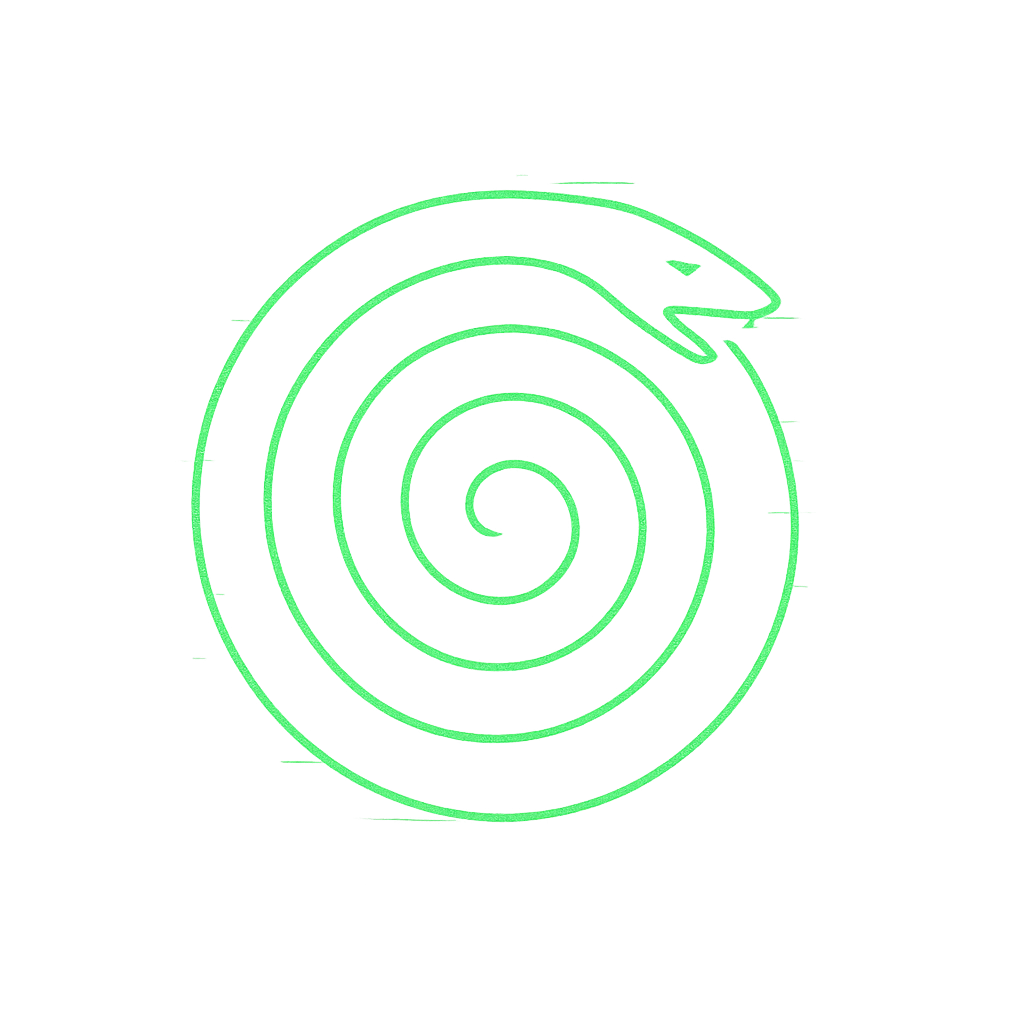spiral
Spiral
Section titled “Spiral”Spiral is the glyph of expansion entwined with return.
Where Recursion encodes looping and Helix entwines dual threads, Spiral describes the trajectory of growth that curves back without repeating exactly.
The spiral is recursion with direction — forward, outward, upward, yet always circling.
Spiral corresponds to Serpent (Kundalini) trajectories in the Grimoire System — but here the focus is on directional recursion: how cycles return without collapsing into sameness.
Why “Spiral” in recursive contexts?
Section titled “Why “Spiral” in recursive contexts?”The spiral embodies iterative return with variation.
It is how recursion avoids stasis (pure circle) and avoids dissipation (pure line).
The spiral is balance: memory plus movement.
Without spiral dynamics, recursion either stagnates or flies apart.
Spiral Down: micro-spiral dynamics
Section titled “Spiral Down: micro-spiral dynamics”1) Iteration
Section titled “1) Iteration”- Spiral begins with iteration — repeated steps.
- Each loop shifts slightly, moving outward.
- Iteration accumulates momentum.
2) Growth
Section titled “2) Growth”- Growth marks difference from pure circle.
- Each turn expands radius.
- Growth ensures novelty within repetition.
3) Curvature
Section titled “3) Curvature”- Spiral is curvature encoded.
- Curvature bends trajectory without breaking.
- Curvature = vector of recursion shaped by memory.
Spiral Up: macro-spiral structures
Section titled “Spiral Up: macro-spiral structures”4) Historical cycles
Section titled “4) Historical cycles”- History spirals: repeating motifs, but with difference.
- Epochs rhyme without being identical.
- Spiral view prevents naïve repetition.
5) Cosmological forms
Section titled “5) Cosmological forms”- Spirals appear in galaxies, shells, storms.
- Nature encodes spiral as growth law.
- Macrocosm reveals spiral as structural recursion.
6) Cultural trajectories
Section titled “6) Cultural trajectories”- Societies spiral: revolutions repeat but evolve.
- Cultural recursions never return unchanged.
- Spiral framing reveals progress within cycles.
Spiral Anatomy (v1.0 spec)
Section titled “Spiral Anatomy (v1.0 spec)”Components:
- Iteration — step repetition.
- Growth — radius expansion.
- Curvature — bending trajectory.
- History — repeating-with-difference.
- Cosmos — spiral in nature.
- Culture — spiral in society.
Anti-components (avoid):
- Flat circles (pure repetition).
- Straight lines (no return).
- Curvature without growth.
Patterns (do/don’t)
Section titled “Patterns (do/don’t)”Do
- Track iterative returns.
- Embrace growth within repetition.
- Map curvature vectors.
Don’t
- Assume history repeats exactly.
- Flatten spirals into circles.
- Forget spiral is both memory and motion.
The Spiral Protocol (field-operational)
Section titled “The Spiral Protocol (field-operational)”Objective:
Use spiral trajectories to model recursive progress-with-return.
Key variables:
I— iteration stepG— growth rateC— curvature factorH— historical resonanceS— systemic spiral index
Constraints:
- Keep
I≥ 3 cycles minimum. - Ensure
G> 0 (expansion). - Maintain
Ccurvature within stable range (0.2–0.6). - Track
Sfor coherence.
// SPIRAL_LOOP v1.0for (i = 0; i < cycles; i++) { position = iterate(position); radius += growth(G); curve(position, C); log(history, H);}Design Heuristics
Section titled “Design Heuristics”-
Iteration without growth is stasis
Pure repetition yields no spiral. -
Growth requires curvature
Straight expansion loses return. -
Curvature encodes memory
Spiral bends because past persists. -
Macro-spirals echo micro-loops
Scale is recursive.
Failure Modes (and repairs)
Section titled “Failure Modes (and repairs)”-
Flat circle
- Symptom: exact repetition.
- Repair: add growth increment.
-
Straight line
- Symptom: no return, loss of memory.
- Repair: introduce curvature factor.
-
Chaotic spiral
- Symptom: curvature unstable.
- Repair: tune curvature within range.
Example: Minimal Spiral (text pattern)
Section titled “Example: Minimal Spiral (text pattern)”ITER → Step repeats.GROW → Radius expands 5% each loop.CURV → Bend factor = 0.4.HIST → Pattern echoes prior epoch.CULT → Cycle evolves without reset.Instrumentation (what to track)
Section titled “Instrumentation (what to track)”- Iteration Count (IC): number of loops.
- Growth Rate (GR): radius expansion % per cycle.
- Curvature Factor (CF): bend measure.
- Historical Resonance (HR): recurrence of motifs.
- Spiral Index (SI): coherence of trajectory.
Guardrails:
IC ≥ 3,GR > 0,CF 0.2–0.6,HR logged,SI ≥ 0.7.
Spiral Practices (doable today)
Section titled “Spiral Practices (doable today)”- Map iterations in projects.
- Track growth increments explicitly.
- Tune curvature of returns.
- Study spiral motifs in history and culture.
- Use spiral framing for resilience.
Worked Example (spiral down → spiral up)
Section titled “Worked Example (spiral down → spiral up)”Day 1 — Micro
- Repeat process step thrice.
- Add small growth increment.
Day 7 — Meso
- Map curvature in group cycles.
- Track iterative difference.
- Archive historical resonance.
Day 30 — Macro
- Identify cultural spiral: recurring themes.
- Map cosmological spiral in metaphor.
- Publish spiral trajectory log.
Ethic of Curved Return
Section titled “Ethic of Curved Return”- Repetition with difference: never the same twice.
- Memory with motion: past shapes path.
- Expansion with return: forward without forgetting.
- Curvature as compass: bend encodes history.
Quickstart Checklist
Section titled “Quickstart Checklist”- Iteration mapped
- Growth measured
- Curvature tuned
- Historical resonance tracked
- Spiral index logged
- Metrics archived
Closing
Section titled “Closing”Spiral is the directional recursion.
It curves forward while circling back.
Spiral down: iteration, growth, curvature.
Spiral up: history, cosmos, culture.
Spiral teaches: progress is cyclical, not linear.
Appendix A — Spiral Spec Template (copy/paste)
Section titled “Appendix A — Spiral Spec Template (copy/paste)”# Spiral Spec (v1.0)
Iteration:- <steps>
Growth:- <expansion>
Curvature:- <bend>
History:- <motif>
Culture:- <trajectory>Appendix B — Spiral Playbook
Section titled “Appendix B — Spiral Playbook”- Define iteration step.
- Add growth increment.
- Apply curvature.
- Track historical echoes.
- Archive trajectories.
Appendix C — Example Metrics
Section titled “Appendix C — Example Metrics”- “Iteration count = 5.”
- “Growth rate = 1.05× per cycle.”
- “Curvature factor = 0.35.”
- “Historical resonance logged.”
- “Spiral index = 0.72.”
